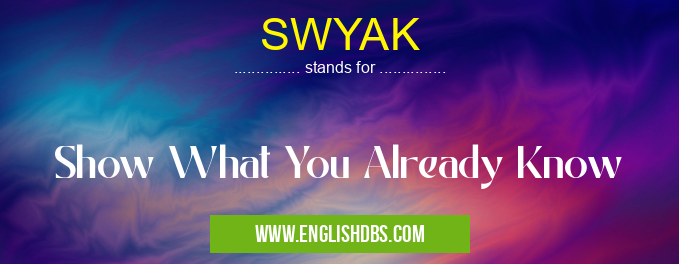What does SWYAK mean in UNCLASSIFIED
SWYAK is an acronym that stands for Show What You Already Know. It is commonly used in educational settings to encourage students to demonstrate their prior knowledge and understanding of a topic before moving on to new material. By SWYAK, learners can identify areas where they need additional support or reinforcement.

SWYAK meaning in Unclassified in Miscellaneous
SWYAK mostly used in an acronym Unclassified in Category Miscellaneous that means Show What You Already Know
Shorthand: SWYAK,
Full Form: Show What You Already Know
For more information of "Show What You Already Know", see the section below.
Benefits of SWYAK
- Identifies Knowledge Gaps: SWYAK helps teachers pinpoint areas where students may have misconceptions or gaps in their understanding.
- Promotes Active Learning: SWYAK encourages students to actively engage with the material and articulate their thoughts and ideas.
- Builds Confidence: By showcasing their knowledge, students gain confidence in their abilities and motivation to learn.
- Tailors Instruction: SWYAK enables educators to tailor instruction based on students' individual needs and learning styles.
- Encourages Self-Reflection: SWYAK prompts students to reflect on their own learning and assess their progress.
Essential Questions and Answers on Show What You Already Know in "MISCELLANEOUS»UNFILED"
What is SWYAK?
SWYAK stands for "Show What You Already Know" and is a technique used in education and training to assess a learner's prior knowledge or understanding of a subject.
What are the benefits of using SWYAK?
SWYAK can help instructors:
- Identify areas where learners need additional support
- Tailor instruction to the specific needs of the group
- Promote active learning and engagement
- Encourage learners to reflect on and articulate their knowledge
How can SWYAK be implemented in the classroom?
SWYAK can be implemented through various methods, such as:
- Asking learners to complete a pre-assessment or survey
- Facilitating brainstorming sessions
- Encouraging learners to share their experiences and perspectives
- Incorporating review activities into lessons
What are some examples of SWYAK activities?
Examples of SWYAK activities include:
- A "Knowledge Map" where learners draw connections between concepts
- A "Concept Wheel" where learners list key terms and their relationships
- A "Pre-Assessment Quiz" to test learners' understanding of specific topics
- A "Case Study Analysis" where learners apply their knowledge to real-world scenarios
How can I ensure that SWYAK activities are effective?
To ensure effectiveness, SWYAK activities should:
- Be aligned with the learning objectives
- Be designed to assess relevant prior knowledge
- Provide clear instructions and expectations
- Be conducted in a supportive and non-judgmental environment
- Be followed by opportunities for feedback and reflection
Final Words: SWYAK is a valuable tool in teaching that enhances student engagement, identifies knowledge gaps, and promotes self-reflection. By SWYAK, educators can create differentiated learning experiences that meet the needs of all learners.
